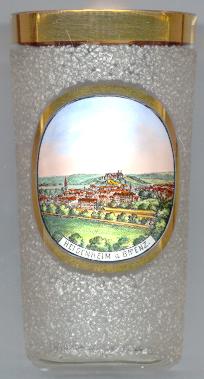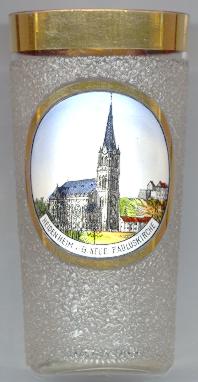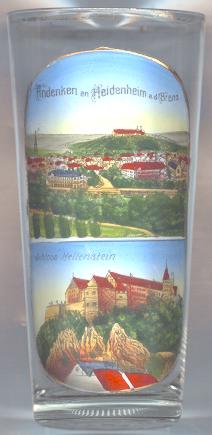

|
| DEUTSCHLAND | GERMANY |
| Bundesland: Baden-Württemberg | |
| Regierungsbezirk: Stuttgart | |
| Landkreis: Heidenheim |

 The area of Heidenheim an der Brenz was already inhabited around 80000 BC in the early Stone Age.
The Romans founded a military post here in AD 85 which later was enlarged to a Roman military settlement.
The military settlement was transferred further north to Aalen around AD 150. The civil settlement existed until about
AD 260 when the Alemanni conquered the Northern border of the Roman empire.
The first mention of the village Heidenheim is found in the Codex Eberhardi of the monastery of Fulda and dates from
before AD 800. The first castle on the Hellenstein hill was founded around 1100 and was completed around 1150.
The fortifications of the village below the castle developped between 1190 and 1420. The formal right of a market town
was confirmed by Emperor Karl IV in 1356.
It was sold to Württemberg in 1448 and to Bavaria-Landshut in 1450. In 1504 it came into possession of Duke Ulrich of Württemberg (1487–1550).
Only between 1521 and 1536 it belonged to the city of Ulm, thereafter it remained part of Württemberg.
Although it was an exclave to the Württemberg countries,
Duke Friedrich I of Württemberg (1593–1608) included the title 'Herr von Heidenheim' (Lord of H.) into the ducal titles and
Duke Eberhard Ludwig (1676–1733) included the town crest of Heidenheim into the ducal coat of arms.
The industrial development of Heidenheim started at the beginning of the 19th century when it became a centre for textile industry.
The railway line along the valley of the river Brenz reached Heidenheim in 1864.
The area of Heidenheim an der Brenz was already inhabited around 80000 BC in the early Stone Age.
The Romans founded a military post here in AD 85 which later was enlarged to a Roman military settlement.
The military settlement was transferred further north to Aalen around AD 150. The civil settlement existed until about
AD 260 when the Alemanni conquered the Northern border of the Roman empire.
The first mention of the village Heidenheim is found in the Codex Eberhardi of the monastery of Fulda and dates from
before AD 800. The first castle on the Hellenstein hill was founded around 1100 and was completed around 1150.
The fortifications of the village below the castle developped between 1190 and 1420. The formal right of a market town
was confirmed by Emperor Karl IV in 1356.
It was sold to Württemberg in 1448 and to Bavaria-Landshut in 1450. In 1504 it came into possession of Duke Ulrich of Württemberg (1487–1550).
Only between 1521 and 1536 it belonged to the city of Ulm, thereafter it remained part of Württemberg.
Although it was an exclave to the Württemberg countries,
Duke Friedrich I of Württemberg (1593–1608) included the title 'Herr von Heidenheim' (Lord of H.) into the ducal titles and
Duke Eberhard Ludwig (1676–1733) included the town crest of Heidenheim into the ducal coat of arms.
The industrial development of Heidenheim started at the beginning of the 19th century when it became a centre for textile industry.
The railway line along the valley of the river Brenz reached Heidenheim in 1864.
The Protestant  Pauluskirche [right] was finished in 1898. The plans in Neo-Gothic
style were drawn by Felix von Berner, architect to the Royal Württemberg court. The church is an excellent example of Historism.
Pauluskirche [right] was finished in 1898. The plans in Neo-Gothic
style were drawn by Felix von Berner, architect to the Royal Württemberg court. The church is an excellent example of Historism.

 Hellenstein castle [left] dates back to the beginning of the 12th century AD.
After a large fire in 1530 the castle was rebuilt. Between 1595 and 1611, the new castle was added at the eastern side of the fortress by Duke Friedrich I of Württemberg.
Famous guests in the castle were: Albrecht of Wallenstein (1630), Prince Eugene of Savoy (1702), Archduke Karl of Austria (1796) and Napoleon Bonaparte (1805).
The old castle fell into dereliction and was pulled down in 1797. The ruins of the old castle are used by the Heidenheim Operatic Summer Festival.
Hellenstein castle [left] dates back to the beginning of the 12th century AD.
After a large fire in 1530 the castle was rebuilt. Between 1595 and 1611, the new castle was added at the eastern side of the fortress by Duke Friedrich I of Württemberg.
Famous guests in the castle were: Albrecht of Wallenstein (1630), Prince Eugene of Savoy (1702), Archduke Karl of Austria (1796) and Napoleon Bonaparte (1805).
The old castle fell into dereliction and was pulled down in 1797. The ruins of the old castle are used by the Heidenheim Operatic Summer Festival.
![[scale]](lineal.jpg)